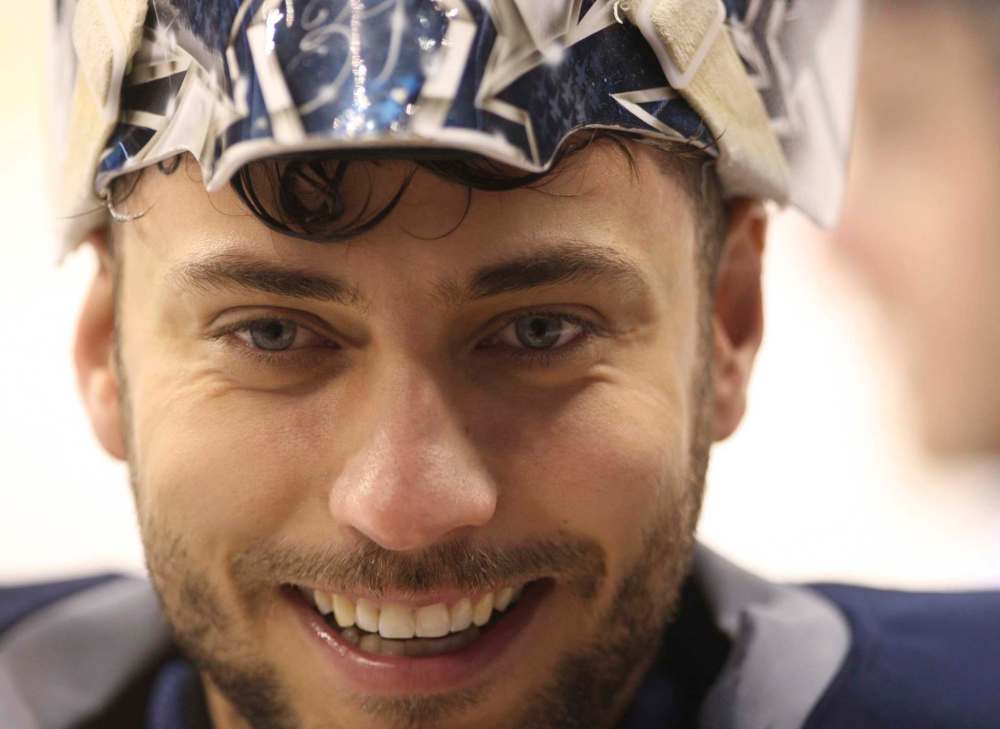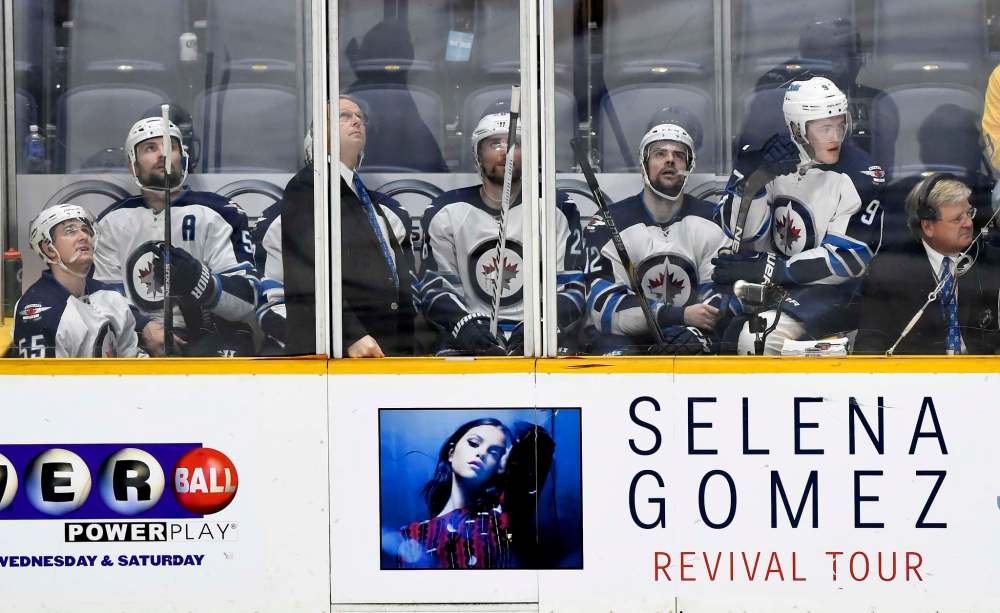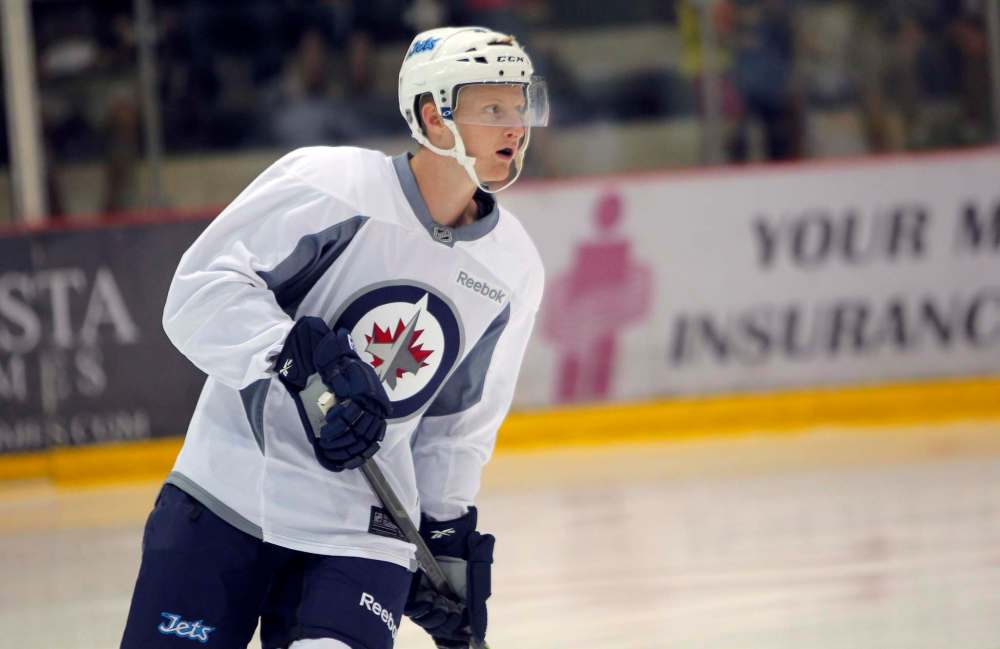Jets autopsy, part 2: Learning from history
The Jets have major issues to resolve before they morph into a Stanley Cup contender
Advertisement
Read this article for free:
or
Already have an account? Log in here »
To continue reading, please subscribe:
Monthly Digital Subscription
$1 per week for 24 weeks*
- Enjoy unlimited reading on winnipegfreepress.com
- Read the E-Edition, our digital replica newspaper
- Access News Break, our award-winning app
- Play interactive puzzles
*Billed as $4.00 plus GST every four weeks. After 24 weeks, price increases to the regular rate of $19.00 plus GST every four weeks. Offer available to new and qualified returning subscribers only. Cancel any time.
Monthly Digital Subscription
$4.75/week*
- Enjoy unlimited reading on winnipegfreepress.com
- Read the E-Edition, our digital replica newspaper
- Access News Break, our award-winning app
- Play interactive puzzles
*Billed as $19 plus GST every four weeks. Cancel any time.
To continue reading, please subscribe:
Add Winnipeg Free Press access to your Brandon Sun subscription for only
$1 for the first 4 weeks*
*$1 will be added to your next bill. After your 4 weeks access is complete your rate will increase by $0.00 a X percent off the regular rate.
Read unlimited articles for free today:
or
Already have an account? Log in here »
Hey there, time traveller!
This article was published 07/04/2016 (3468 days ago), so information in it may no longer be current.
When the goal is improvement, it’s essential to know where you’ve been so that there’s less chance of repeating the mistakes of the past.
It goes to that definition of insanity — doing the same things over and over again and expecting a different result.
The Winnipeg Jets have four of five post-relocation seasons that didn’t involve the Stanley Cup playoffs, including this one, from which to draw.
The season that’s about to end is the most relevant to the discussion about moving forward, which is why Thursday’s Part I, reviewing what went right and what went wrong in 2015-16, was an important refresher course.
Today’s Part II about the key issues as they exist today moves the conversation from what’s past to what things must be tackled in order for the future to turn brighter.
DEPT. OF REDUNDANCY DEPT.
It’s easy to say and hard to do, but defence is the core issue to every path to brighter days.
The Jets of last season proved it again. That team’s move into the top 10 in the NHL in this department triggered a lot of progress. The 210 goals against for the season, the best-ever for the franchise, was a key element of close-game results, goaltending, divisional games. Once it became habit and form, it allowed the Jets to get results even when they weren’t at their best.
This season’s regression underscores the priority. The number is 232 prior to Thursday, putting the Jets literally back to Years 1-3 (246, a pro-rated 246 and 237) in terms of keeping the puck out of their net.
The new, younger Jets of the future might be more skilled than those of the past, but their commitment to defence, not their creativity, is guaranteed to foretell a won-loss record.
THE BLUE PAINT CONUNDRUM

It’s the issue that just doesn’t go away for the Jets, like the persistent pain of a tooth ache that occasionally is so throbbing it becomes debilitating. Three different men — Ondrej Pavelec, Michael Hutchinson and Connor Hellebuyck — made starts for the Jets this season and the man with the best numbers, the rookie Hellebuyck, has been in the minors since mid-February.
Here’s a closer look at the trio:
Pavelec, now 28, is entering the final year of a contract that will pay him $4.75 million, but has a career record of 146-154-47 with a 2.85 goals-against average and .907 save percentage, numbers that mirror his totals for this season (11-13-4, 2.74/.906). He can carry a team for small stretches, as we saw at this time last year, but consistently regresses to those career averages which hardly scream out No. 1 stopper.
Hutchinson, two years younger than Pavelec, is in the final year of a deal that pays him US$575,000 and is a restricted free agent this summer. His numbers this year are similar to Pavelec — 9-15-3; 2.84/.907 — but there are still questions about his game and his consistency. Remember, he was 14-4-2 with a .935 save percentage at the all-star break last year, but is just 16-21-5 since with a save percentage of .899. That represents a frightening decline, but it seems like the Jets aren’t quite willing to give up on Hutchinson without more concrete evidence. Keeping him around provides organizational depth, but goaltenders with those kind of numbers are also available every summer in the free-agent market.
Hellebuyck, who turns 23 in May, was 13-11-1 with a 2.34 GAA and .918 save percentage before his demotion to the Manitoba Moose, where he has four shutouts in 28 games and a 2.45 GAA and .923 save percentage on a team with the worst winning percentage in the AHL. The Jets are being cautious about anointing him as No. 1, but it’s been suggested repeatedly this winter that the two best goaltenders in the organization might now be wearing Moose colours in Hellebuyck and Comrie.
That kind of depth makes this — potentially — less of a concern that at any other point in the franchise’s life here in Winnipeg.
POWER PLAY OR PUNY PLAY?
Another recurring theme for the Jets is their dreadful power-play. It is ranked dead last in the NHL at 14.4 per cent and (not including Thursday’s game in San Jose) is an atrocious four for 56 (7.2 per cent) since March 1.
In the five seasons the team has been in Winnipeg, its power-play ranking has been 11th in Year 1 (buoyed by the second-best home power-play in the NHL), followed by 30th, 25th, 20th and 20th. That’s a whole pile of wasted man advantages.
Now, while everyone is fighting over who to point the fingers at over this problem area, consider this: in the five years the Jets 2.0 have been in Winnipeg, the league’s top five power-plays over that span have been 1. Washington; 2. Pittsburgh; 3. Philadelphia; 4. San Jose; 5. St. Louis.
The top five power-play goal producers during that same span have been 1. Claude Giroux, Pha; 2. Alex Ovechkin, Wash.; 3. Nicklas Backstrom, Wash.; 4. Evgeni Malkin, Pitt; 5. Sidney Crosby, Pitt.
Is it scheme, then, or skill?
YOU’RE KILLING ME
The descent back into the bottom 10 of NHL teams in penalty killing is an offshoot of Point No. 1, defence.
Too many penalties set the table and sketchy execution — including some goaltending — cemented the decline.
The team has had these problems before and no fix has taken long-term.
The combination of anticipation and selective aggressiveness is not always easy to find, but in the late-going this season — and again, take care to over-value these results — the Jets found a better mix of this by turning to Andrew Copp and Alex Burmistrov more in this department.
The Jets’ penalty-killing in the final quarter of the season, then, has improved to 86.5 per cent, which is a top-10 ranking were it that over the course of the year.
THE SIN BIN SYNDROME

This just in: the Jets take a lot of penalties.
And, as a result, one of the most-common shots captured during a Jets telecast is that of head coach Paul Maurice firing some F-bombs at the gentlemen in the striped shirts. Here’s fuel for the conspiracy theorists: in the 80 games the Jets had played heading into last night they were short-handed more than their opponent 40 times, had more power plays than their opponent 25 times and were even on 15 nights.
But here’s another number to munch on: the Jets power-play vs. penalty-kill differential was minus 32 minutes and 25 seconds. And seven other teams were worse, including Anaheim (-94:49), St. Louis (-91:10), Boston (-85:33), Los Angeles (-75:03); Columbus (-46:10), New York Rangers (-41:36) and New Jersey (-40:06). Some of those teams could be playing deep into June.
Clearly, then, it’s not just about staying out of the box.
LOST: A COLLECTIVE RESOLVE
One of the real trademarks of last year’s Jets was their collective backbone. It allowed them to withstand some devastating injuries to their D corps and still morph into a playoff team. Case in point, every significant knockdown seemed to be followed by a rise up off the mat to throw punches again. Last year’s crew won its first game, then lost four in a row. But that was followed by an eight-game point streak (6-0-2).
That theme repeated itself throughout the year: two-game skid answered by a 5-0-3 run; loss followed by 4-0-1; four of five skid, then 6-0-1 stretch; four losses then 2-0-2; two defeats then five-game win streak. And so on.
This year’s crew, for any number of possible reasons, just didn’t answer in the same fashion and that was never more evident than the stat they carried into Thursday’s game in San Jose — 10 times this season they have had a chance to piece together a three-game win streak and 10 times they have whiffed.
COMEBACK KIDDING
Prior to March 12, the Jets were the next thing to money to lose when trailing a game after 40 minutes.
But including that night’s comeback against the Avalanche — the team’s first come-from-behind-after-two win of the season — Winnipeg has rallied four different times in third periods for two victories and two overtime points.
That’s about as much late life and resilience as the Jets have shown in the last two seasons combined. Their cumulative record in this situation for two seasons is 3-27-9.
The Jets were second-worst in this category last season (yes, even qualifying for the playoffs) and rank in the bottom five this season, including recent success.
The team isn’t the worst in third-period goals, 18th overall with 74 prior to Thursday night, but the 74-82 for-and-against difference tells a tale.
STREAK SHREAK

Eighty games and not a single three-game winning streak?
If any one statistic spoke to the crash of this season’s Jets, that’s it.
Is it a mental block? Is it being not good enough? Is it schedule-related?
It’s unlikely Jets’ brass or fans are interested in excuses but if we had to bet, this will be the subject of some soul-searching this off-season among those in charge of coming up with answers and resolutions.
Apart from one very short stretch late last season, the team has never been strong on killer instinct. Can a young and possibly impressionable team be programmed to start thinking this way?
Their future may depend on it.
WIN SOME, LOSE MORE
One area in which growing pains might just have to be accepted for a while is in the faceoff circle.
It’s a problem that’s plagued the team over the years but this season, youth clearly has to be a factor in the Jets’ poor performance in the faceoff circle.
Winnipeg was ranked 28th out of 30 teams as of Thursday, at 46.9 per cent..
The difference between the best teams and the worst in the NHL is less than 10 faceoffs per hundred, but that can amount to a lot of puck possession when games are generally as tight as they are.
The Jets had veteran Bryan Little at a very respectable level this season (51.3 per cent, 1,314 faceoffs taken) but the rest of their young crew were hovering near failing grades.
In order of faceoffs taken, Mark Scheifele was at 44.3 per cent (923 taken), Adam Lowry at 46.5 per cent (813), Alex Burmistrov at 40.1 per cent (489) and Andrew Copp at 46.6 per cent (466).
STRAIGHT OUTTA THE CENTRAL
The Jets picked a few fights in the NHL’s toughest neighbourhood a year ago — and won their fair share, going 16-8-5 overall against Chicago, Dallas, St. Louis, Nashville, Colorado and Minnesota. That was a huge factor in advancing to the Stanley Cup derby.
This year? They’ve regularly had their lunch money stolen by the hombres in this ’hood. They were just 11-16-2 against their own division this winter, a drop of 13 points and won the season series against only one rival, going 4-1-0 vs. the Wild. But here’s the truly scary stat: in 15 of the 29 games against the Central, the Jets surrendered four goals or more. Their goals-against average (heading into Thursday’s game in San Jose) was 2.86 overall, but it was 3.24 vs. the Central this season. Simply not good enough
ed.tait@freepress.mb.ca






